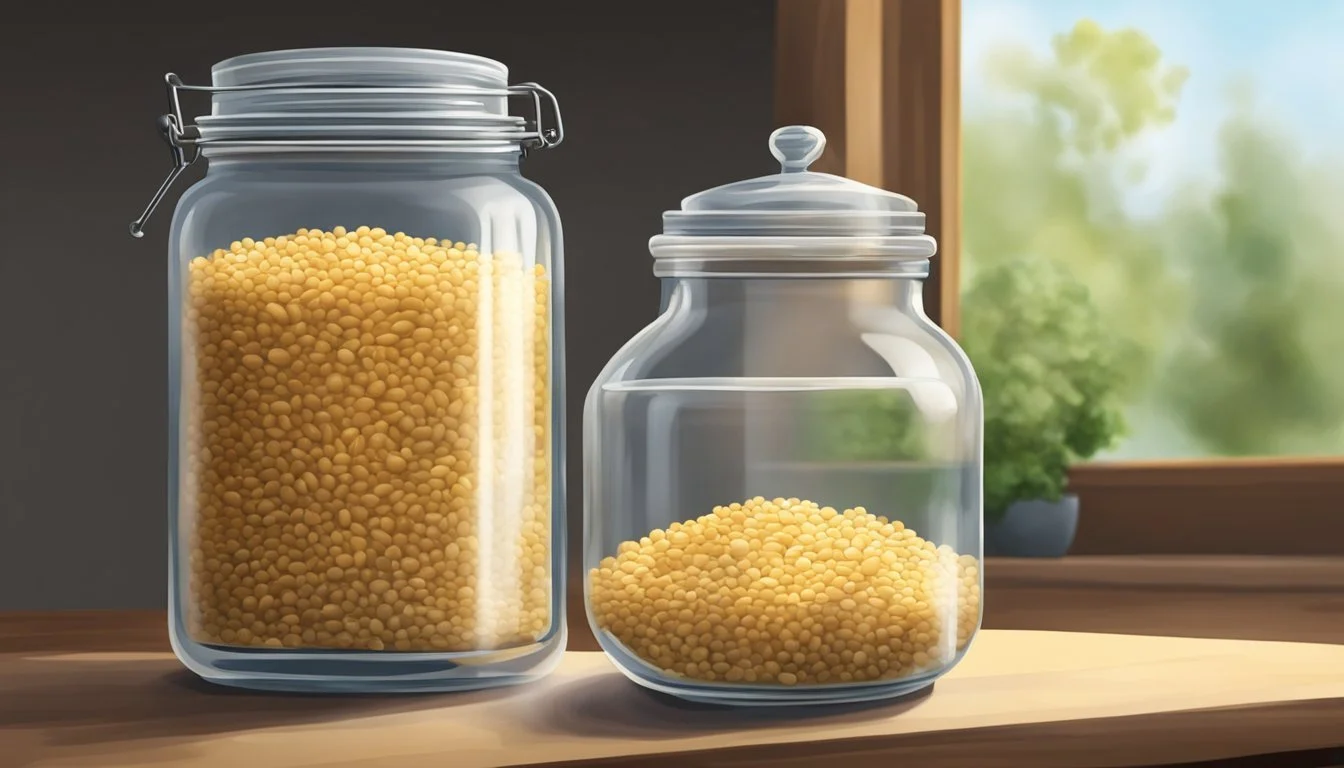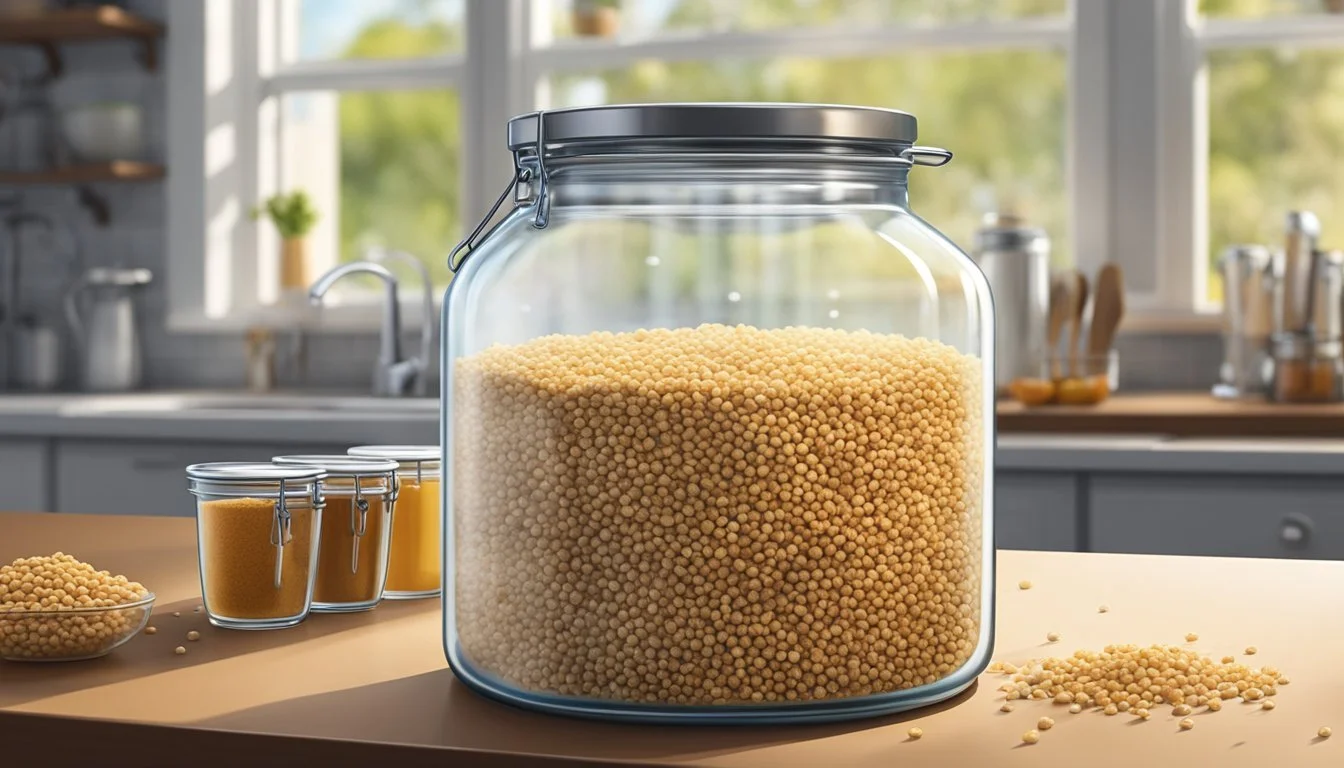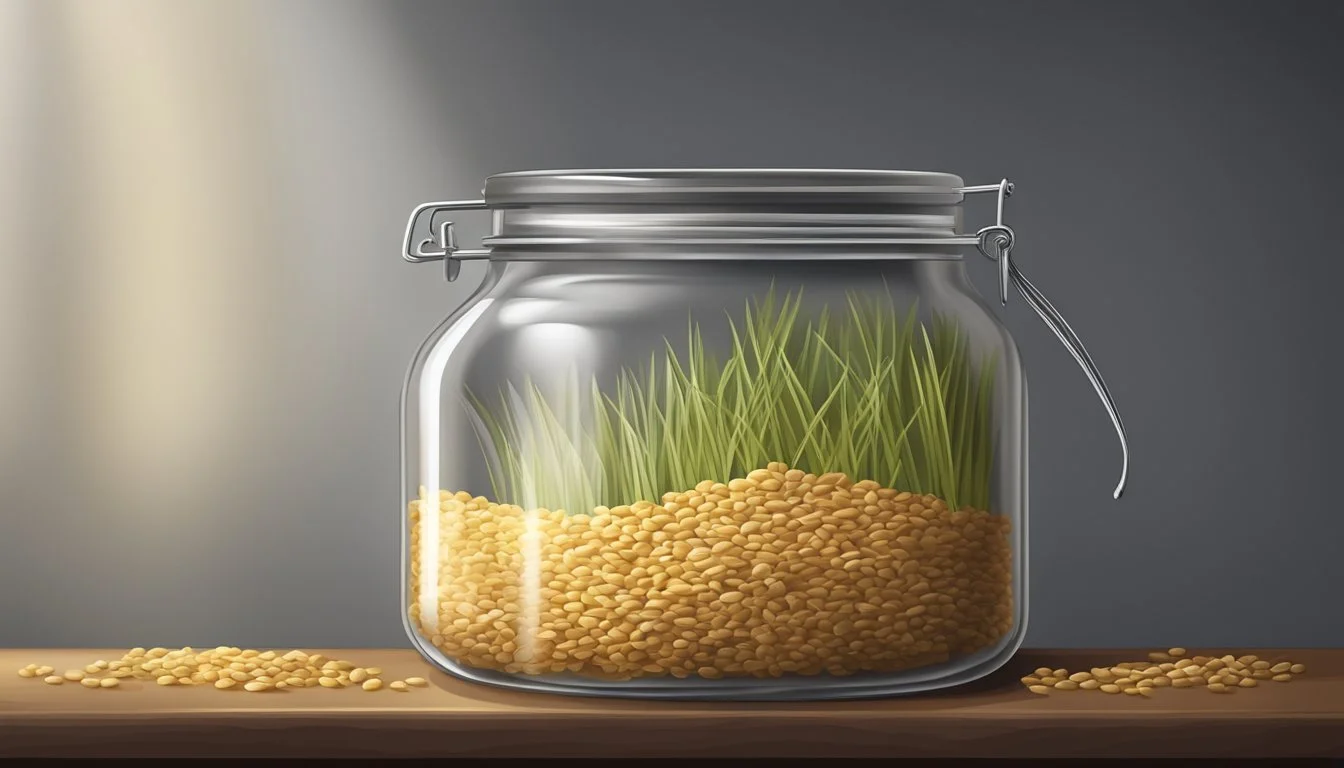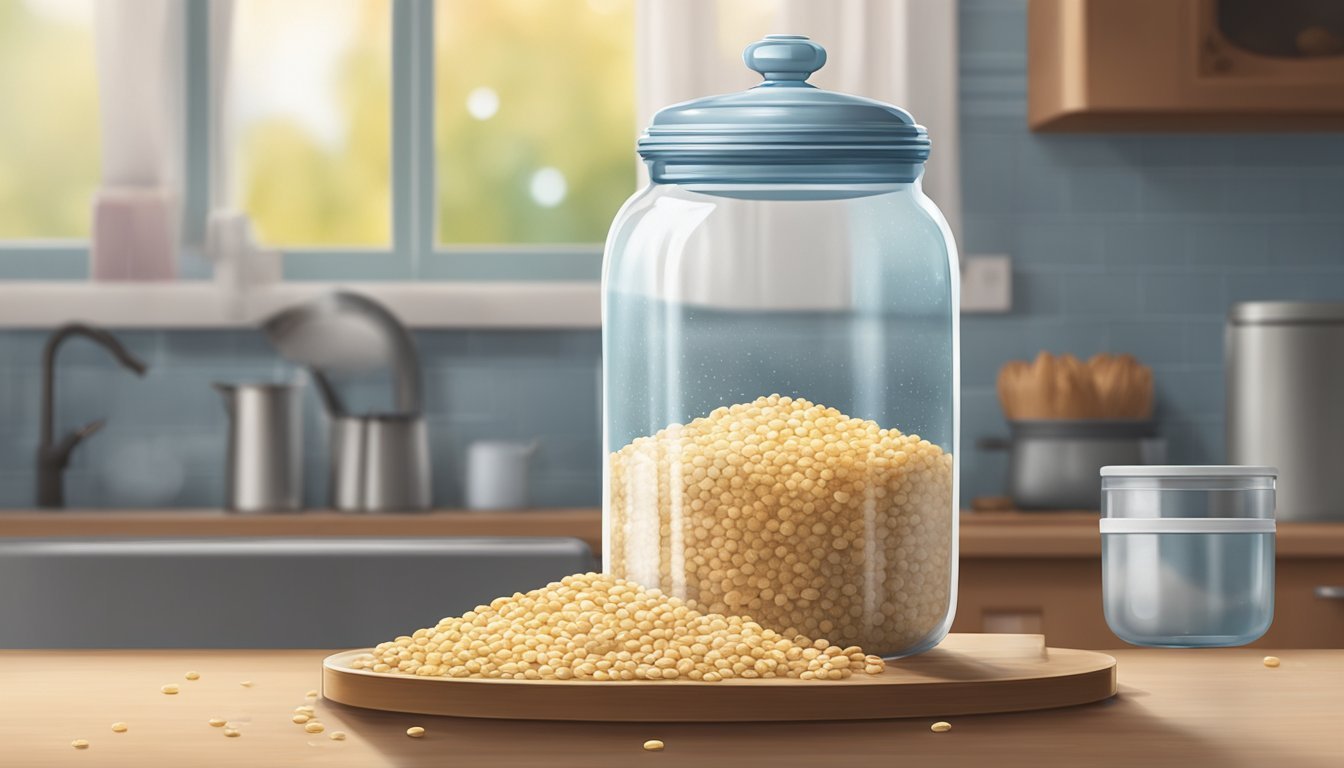How to Ferment Rejuvelac
A Step-by-Step Guide to Crafting Your Own Probiotic Beverage
Rejuvelac is a fermented beverage that has become increasingly popular among health enthusiasts for its purported benefits. Originating from the teachings of Ann Wigmore, a nutritionist who championed wheatgrass and living foods, this mildly tart and slightly fizzy drink is made from sprouted grains. Although Wigmore is often associated with rejuvelac, the drink is not exclusive to her approach and can be enjoyed by anyone interested in fermented foods. (What wine goes well with fermented foods?) The process of making rejuvelac begins with a simple act of sprouting grains, such as wheat berries, rye, quinoa, barley, or oats. The grain is soaked in water for a period leading to germination, after which it is rinsed and mixed with fresh water for fermentation to take place. This fermentation period allows beneficial bacteria to proliferate, resulting in a beverage that is often consumed for its probiotic content.
As a fermented grain drink, rejuvelac is versatile; it can be consumed on its own or used as a starter culture for other ferments. The drink is characterized by its cloudy appearance and can be flavored with lemon or lime to enhance its taste. People who make rejuvelac at home appreciate not only the potential health benefits but also the simplicity of the process, which requires minimal equipment and ingredients.
Choosing the Right Grains
Selecting the appropriate grains is a crucial step in fermenting Rejuvelac, a nutrient-rich grain drink. The type of grain not only influences the flavor but also affects the nutritional profile of the final product.
Popular Grains for Rejuvelac
Among enthusiasts of Rejuvelac, certain grains have gained popularity due to their flavor and fermentation qualities:
Wheat Berries: Known for their robust, classic Rejuvelac taste.
Rye Berries: Contribute a slightly spicy note to the drink.
Barley: Offers a nutty flavor and is traditionally used.
Oat: Delivers a mild, creamy taste, although not as common.
Kamut: Valued for its rich and somewhat sweet flavor.
Gluten-Free Alternatives
For those with gluten sensitivities or celiac disease, several gluten-free grains are suitable for Rejuvelac:
Quinoa: Highly favored for its quick fermentation and beneficial nutrients.
Buckwheat: Despite its name, buckwheat is gluten-free and imparts a distinct taste.
Brown Rice: Provides a milder flavor and is easily accessible.
Millet: Offers a subtle sweetness to the Rejuvelac.
Organic versus Non-Organic Grains
When choosing grains, organic options are often recommended due to the absence of chemicals that could possibly affect the fermentation process or the drinker's health:
Organic Grains: Ensures that the grains are devoid of pesticides and other synthetic agents.
Non-Organic Grains: May be more affordable, but could contain residues of agricultural treatments.
For optimal results in brewing Rejuvelac, organic, sprouted grains tend to be favored as they are believed to yield a higher enzyme content, enhancing both the fermentation process and the nutritional value of the drink.
Preparation Basics
The reader embarks on creating Rejuvelac, a fermented beverage, by gathering specific equipment, following a meticulous soaking process, and adhering to effective rinsing and draining methods.
Equipment Needed
One requires:
A one-quart glass mason jar to facilitate sprouting and fermentation.
Cheesecloth or a clean mesh screen to cover the jar, allowing airflow while keeping contaminants out.
A strainer to rinse and drain grains effectively.
The Soaking Process
To initiate fermentation, one soaks 2 cups of any desired grain in a mason jar filled with clean, pure water. This process, lasting typically overnight or for about 8 hours, kick-starts the germination or sprouting stage critical for Rejuvelac production. It's crucial to ensure a loose lid or breathable cover during this step to maintain proper aeration.
Rinsing and Draining
After the soaking period, the sprouting grains must be thoroughly rinsed with fresh tap or purified water to remove any impurities and support healthy fermentation. They are then drained well to prevent excess water from hindering the process. This rinse and drain cycle occurs regularly throughout the fermentation period until Rejuvelac reaches the desired level of acidity.
Sprouting the Grains
To produce rejuvelac, the sprouting step is crucial—it transforms dormant grains into a living substrate enriched with vital enzymes.
The Sprouting Environment
The environment where grains sprout should be conducive to growth without introducing contaminants. The grains need a setting that's humid and at room temperature—approximately 20-22°C (68-72°F)—to encourage sprouting. They should be kept in a clean, ventilated area away from direct sunlight to prevent overheating and dehydration. Use fresh, filtered water to rinse and soak the grains, as this can affect the quality of the sprouts.
Monitoring Sprout Growth
The growth of the sprouts should be closely observed to ensure they develop properly. After the initial soaking, which typically lasts about 8 hours, the grains should be drained and rinsed several times with fresh water:
Soak grains in fresh, room-temperature water.
Drain and rinse the grains well.
Place the grains in a jar covered with a mesh cloth secured with a rubber band.
Rinsing should be done at least twice a day to keep the grains moist and clean until they begin to sprout, which usually happens within 1-3 days. Sprouts are ready when they have small tails about ¼ inch long. Observing these tails is a clear indication that the grains have sprouted and are prepared for the fermentation process to create rejuvelac.
The Fermentation Process
Fermenting Rejuvelac involves a simple but precise process centering on nurturing the beneficial microorganisms present on grains to create a probiotic-rich beverage. The success of the process depends on maintaining the right conditions and timeframes.
Starting the Fermentation
To initiate the fermentation, one typically begins with sprouted grains, as this state activates the enzymes and increases the availability of natural lactobacillus bacteria on the grain's surface. The grains are first rinsed thoroughly to ensure cleanliness. They are then soaked in clean water, usually in a ratio of 1 part grain to 3 parts water, to begin the fermentation. This soaking environment prepares the ideal setting for the wild fermentation to occur without the need for a commercial starter culture.
Fermentation Duration and Conditions
The duration of fermentation can vary from 1 to 3 days, and the process should take place at room temperature, away from direct sunlight. The vessel should be covered with a mesh or cloth, allowing air to circulate while keeping contaminants out. Stirring the mixture once per day promotes even fermentation and helps distribute yeast and bacteria. The optimal pH for Rejuvelac is slightly acidic, typically around 3.8 to 4.5, as it indicates a successful proliferation of lactic acid-producing bacteria.
Knowing When Fermentation Is Complete
The completion of fermentation can be identified by the distinct tart taste and the presence of bubbles, signifying the effervescent nature of the drink. The beverage becomes cloudy, and a subtle sour aroma can be noticed, indicating the development of lactic acid. Once these signs are observed, the Rejuvelac should be strained to remove the grains and then stored in the refrigerator to halt the fermentation process, thus preserving the fresh, probiotic qualities of the drink.
Flavor and Texture Profiles
The flavor and texture of Rejuvelac can be profoundly influenced by the fermentation process. With careful control, one can cultivate a Rejuvelac that is pleasantly tart and has a consistency that is agreeable to the palate.
Achieving the Desired Tartness
The tartness of Rejuvelac is a direct result of the fermentation duration and the temperature at which it occurs. For a tangy, lemon-like tartness, a shorter fermentation period of approximately 24-36 hours is typically sufficient. It's important to note that a longer fermentation time could lead to an overly putrid taste or an undesirable increase in gas production. Monitoring the smell during fermentation is a reliable way to gauge the development of tartness—aim for a fresh, sour aroma that is not overwhelming.
Adjusting the Texture of Rejuvelac
The texture of Rejuvelac should be slightly cloudy with a light body. To ensure a clean, thin consistency, straining through a fine mesh after fermentation is crucial. Blending the grains well at the beginning will also contribute towards a smoother texture, but remember to strain diligently to remove all grain particles. Should the Rejuvelac appear too thick post-fermentation, it may be thinned out by adding filtered water and stirring thoroughly.
Health Benefits and Nutritional Value
Rejuvelac is a probiotic-rich drink known for its benefits in supporting digestive health and adding nutritional value through its content of vitamins, minerals, and enzymes. It is a significant addition to diets focused on gut health and nutrient acquisition.
Digestive Health
Rejuvelac contributes to digestive health by acting as a digestive aid. It contains good bacteria, such as Lactobacillus, which help to improve digestion and maintain a balance by stifling the growth of bad bacteria. Its lactic acid content aids in mitigating constipation and reducing inflammation within the digestive tract, which can benefit the immune system.
Nutritional Content
Nutritionally, Rejuvelac is enriched with a spectrum of B vitamins, enzymes, amino acids, and minerals essential for maintaining energy levels and overall health. This beverage serves as a natural source of:
Proteins: Essential building blocks for muscle and tissue repair.
Enzymes: Catalysts that facilitate digestion and metabolic processes.
Vitamins: Including B-group vitamins, which are crucial for energy metabolism.
Minerals: Such as magnesium and potassium that support various bodily functions.
Rejuvelac in Alternative Diets
For those following a vegan diet, Rejuvelac offers a valuable alternative to traditional dairy-based probiotic products like yogurt and kefir. It can also be used in the creation of vegan cheese, bringing not only a tangy flavor but also enhancing the cheese with its health benefits. As a non-dairy probiotic, Rejuvelac is a versatile ingredient and beverage that complements a vegan lifestyle while contributing to its nutritional content.
Storage and Preservation
Proper storage extends the lifespan of Rejuvelac, ensuring its benefits are maximized. Refrigeration is crucial in this process, and understanding the signs of spoilage helps in maintaining the quality of the drink.
Refrigeration and Shelf Life
Once fermentation is complete, Rejuvelac should be immediately stored in the refrigerator. This slows down the fermentation process and preserves its freshness. Typically, a batch of Rejuvelac can last for up to one to two weeks when refrigerated. It is essential to store Rejuvelac in airtight containers to maintain its quality and prevent any off-flavors from developing.
Preventing Spoilage
To reduce the risk of spoilage, one must ensure that the Rejuvelac is strained thoroughly before storing to remove any remaining solids, as they can expedite spoilage. It's also critical to use clean utensils when handling Rejuvelac to avoid contamination. One should always smell and taste the Rejuvelac before use; a sour or unpleasant smell is a clear indicator that it should be discarded.
Serving Rejuvelac
Rejuvelac's lightly tart and tangy flavor makes it a versatile fermented beverage. Proper serving ensures that individuals can enjoy its fresh taste to the fullest.
Suggested Serving Methods
Rejuvelac can be consumed directly from a glass jar, chilled for a refreshingly crisp taste, or it can serve as a nutritious start to one's day. For a simple serving method, they should pour it into a glass and drink it as is to fully experience the subtle sourness reminiscent of lemonade. Here are specific ways to serve Rejuvelac:
Plain: Serve chilled in a glass to enjoy its fermenty flavor.
Diluted: For a milder taste, dilute with water or add a squeeze of lemon or lime.
Smoothies: Add to fruit or green smoothies for a probiotic boost.
Seed Cheese: Use as a starter liquid in vegan seed cheese recipes.
Incorporating into Recipes
Incorporating Rejuvelac into recipes enhances food with its probiotic benefits and unique flavor.
Salad Dressings: Use it as a base for vinaigrettes to impart a tangy twist.
Soups: Introduce it into cold soups for an added depth of flavor.
Baking: Employ in place of water to make 'live breads' giving them a fermented edge.
By integrating Rejuvelac into their cooking, individuals can enrich an array of recipes with both the health benefits of fermented foods and the distinctive zest of Rejuvelac.
Troubleshooting Common Issues
In fermenting Rejuvelac, enthusiasts may encounter issues ranging from improper grain sprouting to fermentation difficulties. This section offers guidance on how to identify and resolve these common problems.
Overcoming Challenges in Grain Sprouting
When sprouting grains for Rejuvelac, a key challenge is ensuring they sprout properly, as unsprouted grains can lead to unsuccessful fermentation. If grains are not sprouting:
Check the quality of the grains: They should be whole and unprocessed.
Maintain the right environment: A warm area with indirect sunlight is ideal for sprouting.
Rinse regularly: This prevents mold growth and encourages sprouting.
Addressing Fermentation Problems
Fermentation issues can lead to a compromised Rejuvelac. Here are ways to address them:
Off smells or tastes: A bad smell or taste can indicate contamination. Ensuring all equipment is thoroughly sanitized can prevent this.
Gas, bloating, or diarrhea: These symptoms may occur if Rejuvelac is not fermented properly or if one's digestive system is not acquainted with fermented foods. Start with small quantities and increase gradually.
No fermentation activity: Ensure the room temperature is between 68-78°F (20-25°C) and that the water is clean and free from chlorine.
When straining Rejuvelac, use fine mesh to remove all grain particles, reducing the risk of digestive discomfort.
By closely monitoring the sprouting and fermentation processes and maintaining sanitary conditions, one can successfully ferment Rejuvelac and enjoy its benefits while minimizing digestive issues.
Advanced Tips and Techniques
In elevating your Rejuvelac fermentation process, incorporating nuanced flavors, enhancing probiotic content, and understanding its holistic benefits are key. These advanced techniques go beyond the basics to create a beverage tailored for both taste and health.
Experimenting with Flavors
Rejuvelac's neutral taste makes it an ideal canvas for adding layers of flavor. Incorporate organic citrus peels, such as lemon or lime, for a zesty twist. Infuse with fresh herbs like mint or basil to add complexity. These ingredients not only enhance the flavor but may also contribute additional detoxifying properties to Rejuvelac.
Citrus Peels: Detoxifying, Refreshing
Fresh Herbs: Antioxidant-rich
Berries: Immunity-Boosting
Creating Probiotic-Rich Varieties
To boost the probiotic profile of Rejuvelac, one may adopt techniques from kombucha brewing, such as conducting a two-stage fermentation process. After initial fermentation, adding prebiotic sources like inulin can further nourish the lactobacilli strains, enhancing their growth and potentially the drink's ability to support the immune system.
Use non-chlorinated water to preserve the integrity of the probiotics.
Maintain fermentation at a temperature between 20-25°C (68-77°F) to optimize lactic acid production.
Consider blending Rejuvelac with sauerkraut juice, which is rich in probiotics, for a synergistic effect.
Rejuvelac in Holistic Practices
In holistic health, Rejuvelac is often acknowledged for its non-alcoholic, laxative properties, making it a preferred immune system support drink. Some suggest its regular consumption may reduce the risk of vaginal yeast infections and other types of infections. While not a cure for diseases such as cancer, the live cultures may contribute to a balanced gut microbiota, which plays a role in overall well-being.
Integrate Rejuvelac into a daily routine alongside other fermented foods such as wheatgrass for enhanced effects.
Consider its use as part of a detoxifying, restorative diet, but do so in moderation.
Always consult with a healthcare provider before using Rejuvelac as a remedy for health conditions.
Safety Considerations
When fermenting Rejuvelac, the drink's safety is paramount. A successful ferment contains beneficial lactobacilli probiotics, which can aid in digestion. In contrast, an improper ferment can lead to putrid smells, harmful bacteria, and health risks, such as bloating or infections.
Identifying Unsafe Fermentation
Odor: A healthy Rejuvelac has a slightly sour, lemony scent. If the smell is offensive or putrid, the batch may be compromised.
Appearance: Look for clarity in the liquid after straining. Cloudiness is normal but if there are signs of mold or odd colors, discard it.
pH Levels: A pH of around 3.5 to 4.5 indicates a good ferment. Higher pH levels suggest inadequate fermentation and potential for pathogens.
Preventing Contamination
Filtered Water: Always use filtered water, as tap water may contain chlorine and other chemicals that can kill beneficial lactobacilli.
Organic Grains: One should opt for organic grains to minimize the risk of pesticide residues, which could interfere with the probiotics.
Sterile Equipment: Sterilize jars and tools to prevent the introduction of harmful microorganisms.
Straining: Proper straining is crucial to remove grain particles that can spoil the Rejuvelac.
Temperature: Maintain fermentation at room temperature, as too high or too low temperatures can promote the growth of harmful bacteria.
Conclusion
Rejuvelac is a unique fermented grain drink that boasts a variety of potential health benefits, deriving from the process of fermenting sprouted grains. This mildly tart beverage serves as a rich source of probiotics, beneficial enzymes, and B vitamins which are known to support digestive health and boost overall wellness.
One should consider incorporating Rejuvelac into their diet for its digestive support and nutrient profile. Since it is easy to prepare at home, individuals can enjoy fresh, homemade Rejuvelac with minimal effort. Here is a brief recap of the preparation process:
Begin with rinsing and soaking the selected grains
Allow for sprouting, typically taking a few days
Blend sprouted grains with fresh water and ferment
Strain the liquid for a ready-to-drink Rejuvelac
Homemakers should ensure the use of organic grains to avoid unwanted chemicals and taste the Rejuvelac regularly to ensure it has not gone putrid, especially in warmer climates.
It is important to note that while many enjoy the tangy flavor of Rejuvelac, some might find it an acquired taste. Experimentation with different grains such as quinoa, rye, barley, or wheat may yield varying flavors and textures.
Given its simplicity in production and possible health advantages, Rejuvelac can be a valuable addition to one's diet. However, individuals with specific health conditions or dietary restrictions should consult a healthcare professional before regular consumption.
Resources for Further Learning
For those wishing to deepen their knowledge on the fermentation process of Rejuvelac and its uses, there are comprehensive resources available that span from expert literature to online community insights.
Books and Publications
Ann Wigmore: A pioneer in the field of natural health and the promotion of Rejuvelac, she has authored books that delve into its benefits and preparation methods. Interested readers may seek her publications for a detailed understanding of this probiotic drink.
The Sprouting Book: This book provides information on sprouting techniques, which are fundamental to preparing Rejuvelac. It covers the essentials of grain sprouting, a key step in Rejuvelac production.
Online Communities and Forums
Home Fermentation Forums: Many online platforms exist where fermentation enthusiasts share their experiences, recipes, and tips for making Rejuvelac.
Social Media Groups: Platforms like Facebook and Reddit have dedicated groups for fermentation where one can find discussions about Rejuvelac, its fermentation process, and its uses.
By exploring these resources, individuals can gain a comprehensive understanding of Rejuvelac, from the foundational methods promoted by Ann Wigmore to shared community practices.
Appendix
This Appendix serves to enhance understanding of the fermentation process of Rejuvelac and answer common queries related to its preparation.
Comprehensive Glossary
Fermentation: The chemical process by which an organism converts carbohydrates, such as starch or sugar, into alcohol or acid; in the case of Rejuvelac, beneficial bacteria and yeast convert sugars from sprouted grains into lactic acid.
Phytic Acid: An anti-nutrient found in grains and seeds which, when broken down through soaking and fermenting, improves digestibility.
Sprouted Grains: Grains that have been soaked and allowed to germinate, which initiates fermentation.
Lactic Acid Bacteria (LAB): Bacteria that play a crucial role in the fermentation process, producing lactic acid which adds to the tangy flavor of Rejuvelac and helps preserve it.
FAQs About Rejuvelac
Q: What grains can be used to make Rejuvelac?
A: Common grains include wheat, rye, barley, millet, and quinoa.
Q: How long does it take for Rejuvelac to ferment?
A: Typically, Rejuvelac takes about 1-3 days to ferment, depending on the ambient temperature and the potency of the grains.
Q: How can one tell when Rejuvelac is ready?
A: It should have a tart, lemony scent, a cloudy appearance, and a taste slightly sour.
Q: Is it safe to drink Rejuvelac every day?
A: Yes, consumed in moderate amounts, it can be a part of a daily diet. However, one should listen to their body and adjust intake accordingly.
Q: How should Rejuvelac be stored on completion of fermentation?
A: It should be refrigerated which slows down the fermentation process and preserves the drink for longer.
About the Author
The author of this article is a seasoned food scientist and fermentation enthusiast. With a Bachelor's degree in Food Science and a Master's in Microbiology, they have dedicated over a decade to studying the art and science of fermentation.
Experience:
Over 10 years in the field of fermentation science
Published multiple peer-reviewed articles on probiotics and food preservation
Expertise:
Specializes in the cultivation of beneficial microorganisms
Adept in the practical applications of fermentation for health and culinary uses
The author's work primarily involves research on probiotic cultures and educating the public on the benefits of fermented foods. Rejuvelac, the subject of their latest article, is a prime example of their expertise in turning simple ingredients into nutritious, probiotic-rich beverages.
Contributions:
Regularly conducts workshops on homemade fermentations
Volunteer lecturer for community health programs
The author's approach is always grounded in empirical research, striving for clarity and accessibility in their writing. Their aim with the current article on Rejuvelac is to demystify the fermentation process, making it approachable for both beginners and seasoned fermenters alike. They believe that knowledge about fermented foods, such as Rejuvelac, can lead to improved health and wellness for all.
Acknowledgments
This article on fermenting Rejuvelac benefitted greatly from a variety of expert sources and contributions. The authors would like to acknowledge Food Fermented for its comprehensive guide on preparing grains for fermentation. Their method of soaking grains and blending them to break them down has been a fundamental step in the process.
The team at Superfood Evolution also provided valuable insights, especially regarding the importance of rinsing grains and the use of clean, pure water for soaking. Their emphasis on hygiene is reflected in the recommended practice of using a mesh lid for straining the grains.
Special thanks go to My Fermented Foods for highlighting the usage of organic seeds to avoid chemical contaminants, and for the innovative idea of adding lemon or lime juice not only for flavor but also as a natural preservative. Their resourceful tips on using spent grains to bake 'live breads' demonstrate the sustainable approach one can take with Rejuvelac.
Appreciation is given to Changing Habits for informing about the fermentation time and the signs of properly fermented Rejuvelac. They helped in discerning the quality of Rejuvelac by its yeasty smell and lemon-like flavor, ensuring that one can recognize when the beverage is ready for consumption or has gone putrid.
Lastly, the article recognizes the joint efforts of all those who practice and perfect the art of fermentation. Their collective wisdom has helped in shaping a clear and accurate guide to creating this nutritious fermented grain drink.









